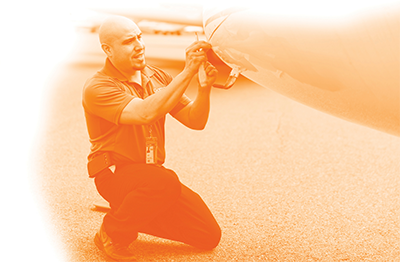The ongoing demand for business aviation pilots can overshadow equally urgent needs in other industry roles, including airframe and powerplant (A&P) mechanics and aviation maintenance (AMT) and avionics technicians. Flight departments must reexamine past approaches to hiring and retaining AMTs and take an honest look at how they fit – and may not fit – with the current environment.
“It’s about meeting students where they are and creating that personal connection,” said Jim Elston, senior director of aviation for Coca-Cola Consolidated and chair of the NBAA Scholarships Committee. “That can mean spending a lot more resources and energy to develop those relationships and stay connected, but there’s value there.”
While it may seem that larger companies may have an advantage in recruiting new talent, it’s important that flight departments of all sizes leverage their local educational institutions to find qualified workers.
“Developing that grassroots approach and having points of contact in the local area is important,” said the director of maintenance for a large business aviation flight department. “Even a smaller flight department has the ability to bring local college or technical A&P students to their hangar and show them the work they do on their airplanes and what life in business aviation looks like.”
Crystal Maguire, executive director of the Aviation Technician Education Council (ATEC), noted schools have also opened their doors to aviation maintenance companies. “I was just at [the local campus of a national community college program] and one company literally had tables set up on the crossway to engage with students passing between classes,” she said. “They’re always open.”
Although many colleges have traditionally prioritized developing hiring pipelines to the airlines, even that is changing, noted Dr. Alan Stolzer, dean of the College of Aviation at Embry-Riddle Aeronautical University.
“I don’t think we’ve done a good enough job making students aware of all the different possibilities in aviation,” Stolzer said. “We are doing better now, including an increased emphasis on business aviation, both for pilots and maintenance personnel.”
“Companies need to challenge the norms and ask themselves, ‘why do we require x number of years’ experience?’”
Dr. Alan Stolzer Dean of the College of Aviation at Embry-Riddle Aeronautical University
United Efforts and Avoiding Silos
Efforts to attract new aviation maintenance professionals should also complement programs aimed at drawing other positions to the industry. “Flight departments are pooling their resources in terms of ideas and talent in order to speak with a much louder voice,” Stolzer noted. “That’s even more important when you’re a smaller organization.”
“We’ve tried in our organization to build the culture where we’re no longer technicians or pilots,” Elston noted. “We’re advocates for the brand and for our teammates, and we’re also advocates for business aviation as a whole.”
Flight departments may also need to reexamine their hiring traditional requirements. “Companies need to challenge the norms and ask themselves, ‘why do we require x number of years’ experience?’” Stolzer said. “A lot of times, the answer is ‘because we’ve always done it that way,’ but right now they may not have the luxury of demanding three, five or eight years of experience working on jet aircraft.”
Colleges and universities have also adapted their approaches. Stolzer pointed to greater emphasis on developing baseline skills that students can take to their first AMT job. “A well-trained technician is productive from the get-go,” he said. “The high-quality training they’ve received will more than make up for sometimes-arbitrary experience requirements.”
“Schools can now offer part 147 programs that are better aligned in scope and timeframe with other program offerings, such as automobile maintenance, which often draw from the same talent pool.”
Crystal Maguire Executive Director of the Aviation Technician Education Council
Regulatory overhauls to 14 CFR Part 147 aviation maintenance technical schools (AMTS) now allow more flexible approaches to training by shifting to competency- and performance-based training methodologies for aviation maintenance professionals.
Maguire noted the FAA recently published its new mechanic airman certification standards, a significant step forward after the new rule became effective in September 2022. “That gives schools the tools they need to tailor their programs to the needs of their students and the industry, while also fulfilling the agency’s intent with this program,” she said.
 Under the new guidelines, AMTS training curricula does not require FAA approval, although the agency maintained its testing authority and will continue to oversee a school’s equipment and faculty. Maguire noted the shift from an hours-based curriculum should make aviation maintenance a more attractive proposition to students.
Under the new guidelines, AMTS training curricula does not require FAA approval, although the agency maintained its testing authority and will continue to oversee a school’s equipment and faculty. Maguire noted the shift from an hours-based curriculum should make aviation maintenance a more attractive proposition to students.
“Schools can now offer Part 147 programs that are better aligned in scope and timeframe with other program offerings, such as automobile maintenance, which often draw from the same talent pool,” she said. “An AMT program no longer requires significantly more time to complete, as long as it still meets the
end goal.”
Getting Savvy
Social media can also play a role in attracting talent, as Elston recently saw firsthand with a student who posted his experiences during an eight-week summer internship program.
“It was really eye-opening to see people reaching out to him to ask, ‘how can I apply for that internship? Are there other places I can go?’” Elston said. “We talk about social media in our industry, but we aren’t as savvy as younger kids and students who have influence.”
“Most organizations use these airplanes because it’s about time, security, privacy and safety. Helping young people see that has been a challenge.”
Jim Elston Senior Director of Aviation for Coca-Cola Consolidated
Even established industry professionals may find themselves taken aback. Stolzer termed a recent visit to a large business aviation flight department as, “mind boggling.”
“Our guide was one of their pilots and one of NBAA’s Top 40 Under 40, in fact,” he said. “She and other young people are operating the most sophisticated jets on the planet. AMTs are working on these amazing and incredibly high-tech vehicles. I think a lot of people would be surprised by how advanced these aircraft are.”
 “Airlines are very good at advertising,” Elston said. “We do need to figure out as an industry how to better market our industry. Most organizations use these airplanes because it’s about time, security, privacy and safety. Helping young people see that has been a challenge.”
“Airlines are very good at advertising,” Elston said. “We do need to figure out as an industry how to better market our industry. Most organizations use these airplanes because it’s about time, security, privacy and safety. Helping young people see that has been a challenge.”
“Our industry excels at privacy,” added the maintenance director. “We want to protect our companies and not draw too much attention to ourselves. If we’re looking to grow from within or create growth opportunities, we need to get uncomfortable, in a sense. We must seek out those opportunities to speak with people who don’t otherwise know that our industry exists.”
While much of the industry’s emphasis has been on attracting young workers to the industry, Maguire also emphasized growing availability of programs for those who may wish to change careers later in life.
“This is the same general content we use in AMT schools but folded into a 12- to 16-week adult learning course, which I think is pretty cool and unique,” she said. “Here in Oklahoma, we’re also talking with local tribal governments. They have adults they want to transition to work, and we have the jobs.”
Upon completion of these courses, students may work as a non-certificated technician while gaining valuable hands-on experience. “We’re seeing a lot of interesting opportunities with that model,” Maguire continued. “There are part-time and night school A&P programs for those transitioning to something else or need to have a quick task to work.”
 While the industry faces an uphill climb on hiring new aviation maintenance professionals, “we are doing some things pretty well,” Stolzer said. “We have the attention of Congress and the Department of Transportation on workforce issues. We’ve also increased our outreach to women and other groups, and they’re becoming more involved in aviation maintenance.”
While the industry faces an uphill climb on hiring new aviation maintenance professionals, “we are doing some things pretty well,” Stolzer said. “We have the attention of Congress and the Department of Transportation on workforce issues. We’ve also increased our outreach to women and other groups, and they’re becoming more involved in aviation maintenance.”
For business aviation flight departments, “it’s almost like being a vacuum salesman,” the maintenance director concluded. “We’re knocking on Part 147 schools’ doors and saying, ‘we have a flight operation, we have a need, and we would like to tell you about it.’ Getting the foot in the door is incredibly important.”



 International Business Aviation Council Ltd.
International Business Aviation Council Ltd.